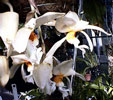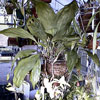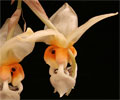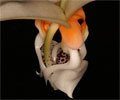|
|
|
|
|
| |
Flasks of
Stanhopea embreei 'Taylor el Toro' × self |
|
| |
|
|
| |
| Number: |
TN3342 |
| Name: |
Stanhopea embreei 'Taylor el Toro' × self
|
| Type: |
self (What's that?) |
|
Seed Donor: |
David R. Janvrin
|
|
Click to Enlarge

Pod Parent Flowers |
Click to Enlarge

Pod Parent Blooming Plant |
Click to Enlarge

Offspring 'Sherwood's Folly' Flower |
Click to Enlarge

Offspring 'Sherwood's Folly' Closeup of Flower |
| Offspring photos are siblings of the plants you would receive. |
|
|
|
| |
Culture Notes from Donor: Parent plant: Temperature range I (60-83°F). Warm and wet with abundant fertilizer during the spring and summer months with a short winter rest.
Comments: Parent plant: This is an heirloom division of the 1972 CCM plant labeled "Stanhopea wardii 'Taylor el Toro" which has recently been identified by Christenson as S. embreei. Once established in a basket, it is a rampant grower and reliable bloomer. This year, it has produced seven inflorescences over a period of three months averaging four flowers per inflorescence. Very large plant.
For additional origin/habitat information supplied courtesy of
Charles and Margaret Baker, see further below, near the bottom of this page.
|
Temperatures we attempt to use in the lab & greenhouse:
| For Species: |
|
Spring, Summer, Autumn, Winter: days average 85°F, nights 67°F; best fit is Warm-Intermediate 87-64°F
(Source:
Baker's Web OSC) |
|
About the name...
| Etymology of |
embreei |
|
Named for Alvim Embre, American orchid enthusiast and botanist of the 20th century.
(Source:
Mayr & Schmucker 1998) |
| Etymology of |
Stanhopea |
|
In honor of Philip Henry, 4th Earl of Stanhope, president of the London Medico-Botanical Society during the early part of the 19th century.
(Source:
Pridgeon 1992) |
| Pronunciation of |
embreei |
|
EM-bray-eye
(Source:
Greer 1998) |
| Pronunciation of |
Stanhopea |
|
stan-HOPE-ee-ah
(Source:
Pridgeon 1992) |
|
If you would like to direct someone to this web page, please copy and paste this URL into your email:
http://troymeyers.com/d?013342
| Flask Information |
| Availability: |
We have sold all of the flasks for this item. |
| You should: |
Consider getting individual plants or compots instead of a flask.
You can place a "Notify Flask Recipients" Request, and either we or a flask recipient may contact you when plants are available.
You may also place a "Notify Retries" Request, and if an identical pollination (the same parents) is done again, we'll let you know.
You may reserve a flask, but it's very unlikely you'll get one ...this could only happen if we found a flask that we didn't know we had. |
| Yield Estimate: |
332 plants (based on flask surveys done 02/05/2003 )
|
| Plantlet Sizes: |
From many flasks 35 - 50 mm plants (based on flask surveys done 04/08/2003 )
From one most recently surveyed flask 35 - 50 mm (04/08/2003)
|
|
You might also want to:
|
View the seed assay for this item.
View items of the same species.
View items of the same genus.
|
| Ordering Information |
| You are not currently logged in. |
|
You must be a registered user and be logged in to reserve a flask or place a notification request. Please log in:
|
|
|
|
|
|
| |
The origin/habitat information below is supplied courtesy of Charles and Margaret Baker
The following information is based on the name of the plant provided by the donor, and assumes that the name is correct. If the plant has been misidentified, then the following information may not be correct.
This text is copyrighted by the Bakers and may not be reproduced without permission.
ORIGIN/HABITAT: Western Ecuador. Plants are found in wet mountain
cloudforest in Chimborazo and Cañar Provinces. In Cañar, plants have been
collected at mile 58 (km 94) between Durán and Tambo at 3300ft. (1000 m).
In Chimborazo it was found at mile 62 (km 100) along the railroad from
Guayaquil to Quito at 1950 ft. (600 m).
More about this information and the Bakers...
|
|
|
| |
|
|
|